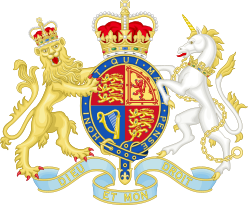Frederick North, 2. Earl of Guilford

Frederick North, 2. Earl of Guilford KG PC (* 13. April 1732 in London; † 5. August 1792 ebenda), von 1752 bis 1790 bekannt unter dem Höflichkeitstitel Lord North, war ein englischer Politiker. Von 1770 bis 1782 war er Premierminister von Großbritannien und einer der Hauptakteure im Konflikt um die amerikanische Unabhängigkeit.
Leben
Frederick North war der Sohn von Francis North, 1. Earl of Guilford (1704–1790) und dessen erster Gattin Lady Lucy Montague († 1734). Er wurde am Eton College und am Trinity College in Oxford ausgebildet.
Er war von 1754 bis 1790 für Banbury Mitglied des House of Commons und war erstmals als junior Lord of the Treasury seit dem 2. Juli 1759 in der Newcastle-Pitt-Koalition an der Regierung beteiligt.
Im Dezember 1767 wurde er Nachfolger von Charles Townshend als Schatzkanzler.[1] Als Augustus FitzRoy, 3. Duke of Grafton, als Premierminister zurücktrat, bildete North am 28. Januar 1770 eine neue Regierung.[2] Ab 1778 war er Lord Warden of the Cinque Ports. Er trat am 27. März 1782 als Premierminister infolge der britischen Niederlage bei der Schlacht von Yorktown ein Jahr zuvor zurück.[2] Das Schwergewicht seiner Regierungszeit lag zunächst auf den wachsenden Problemen in den amerikanischen Kolonien und später auf dem Amerikanischen Unabhängigkeitskrieg.

Im April 1783 kehrte North als Innenminister in der ungleichen Koalition mit dem radikalen Whig-Führer Charles James Fox unter der offiziellen Führung von William Henry Cavendish-Bentinck, 3. Duke of Portland, an die Macht zurück. König George III., der Fox verabscheute, verzieh diesen beabsichtigten Verrat nie, und North war nicht wieder in der Regierung tätig, nachdem er im Dezember 1783 aus ihr ausgeschieden war.
Er gab seinen Sitz im Unterhaus 1790 auf, nachdem er erblindet war. Im selben Jahr trat er die Nachfolge seines Vaters als Earl of Guilford an und war damit bis zu seinem Tod Mitglied des House of Lords.
Ehe und Nachkommen
Seit dem 20. Mai 1756 war er mit Anne Speke verheiratet. Mit ihr hatte er sechs Kinder:
- Charlotte North († 1849)
- Anne North († 1832)
- George North, 3. Earl of Guilford (1757–1802)
- Catherine Anne North (1760–1817)
- Francis North, 4. Earl of Guilford (1761–1817)
- Frederick North, 5. Earl of Guilford (1766–1827)
Literatur
- Dick Leonard: Frederick North, styled Lord North: Outstanding parliamentarian, pity about the colonies. In: Dick Leonard: British Prime Ministers from Walpole to Salisbury. The 18th and 19th centuries. Band 1, Routledge, London 2021, ISBN 978-0-367-46911-5, S. 117–131.
Einzelnachweise
- ↑ Powicke & Fryde: Handbook of British Chronology. Second Edition, London, 1961, S. 105
- ↑ a b Powicke & Fryde: Handbook of British Chronology. 2. Auflage. London 1961, S. 108.
Weblinks
- Kurzbiografie der Website von Number 10 Downing Street (englisch)
- Frederick North, 2nd Earl of Guilford auf thepeerage.com, abgerufen am 14. September 2016.
| Vorgänger | Amt | Nachfolger |
|---|---|---|
| Francis North | Earl of Guilford 1790–1792 | George North |
| Personendaten | |
|---|---|
| NAME | North, Frederick, 2. Earl of Guilford |
| ALTERNATIVNAMEN | North, Frederick; North, Lord |
| KURZBESCHREIBUNG | Premierminister von Großbritannien |
| GEBURTSDATUM | 13. April 1732 |
| GEBURTSORT | London |
| STERBEDATUM | 5. August 1792 |
| STERBEORT | London |
Auf dieser Seite verwendete Medien
Autor/Urheber: Berlin-George, Lizenz: CC BY-SA 3.0
End of American War of Independence 1782 Silver Medal
14.25 g Sterling Silver. D = 32 mm
Lord North (Frederick North), 1732 London - 1792 London, England
Scene in the British Parliament, 4 lines below in exergue: "HOUSE OF COMMONS VOTES TO END THE WAR 1782"/ 7 lines below military symbols: "FEBRUARY 27, 1782 British legislators vote against continuing the war. On March 20, Lord North resigns as Prime minister despite the wishes of King George III."
Franklin Mint edition 1971.
Condition: Lightly toned EXTREMELY FINEAutor/Urheber: Sodacan, Lizenz: CC BY-SA 3.0
Royal Coat of Arms of the United Kingdom of Great Britain and Northern Ireland in the style used by the Government of Queen Elizabeth II from 1952 to 2022 (as used in all places except Scotland).
| “ | Quarterly, First and Fourth Gules three lions passant guardant in pale Or armed and langued Azure (for England), Second quarter Or a lion rampant within a double tressure flory counter-flory Gules (for Scotland), Third quarter Azure a harp Or stringed Argent (for Ireland), the whole surrounded by the Garter; for a Crest, the imperial crown Proper; for Supporters, dexter a lion rampant guardant Or crowned as the Crest, sinister a unicorn Argent armed, crined and unguled Proper, gorged with a coronet Or composed of crosses patée and fleurs de lys a chain affixed thereto passing between the forelegs and reflexed over the back also Or; Motto 'Dieu et mon Droit’ ('God and my Right') below the shield. | ” |
- PINCHES, J.H & R.V., The Royal Heraldry of England, 1974, Heraldry Today.


